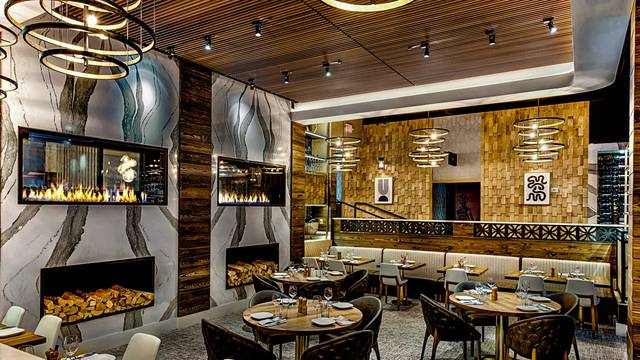Instagrammable Restaurants Islamabad: Picture-Perfect Dining Experiences
Instagrammable Restaurants Islamabad: Picture-Perfect Dining Experiences
Blog Article
Savor Authentic Asian Food With a Pan-Asian Spin for a Culinary Adventure
Getting started on a cooking trip via authentic Asian food, enhanced with a Pan-Asian spin, provides an unique opportunity to explore the abundant tapestry of tastes that define the area's varied cooking practices. This experience invites you to enjoy the elegant balance of tastes-- sweet, salted, spicy, and sour-- balanced by aromatic herbs and flavors. Think of the ingenious combination of Thai curry and ramen or the unanticipated joy of sushi burritos. As you contemplate these tempting recipes, take into consideration the cultural narratives and historic impacts that form them, each bite offering a story waiting to be uncovered.

Exploring Pan-Asian Flavors
In the realm of global gastronomy, Pan-Asian cuisine sticks out for its impressive diversity and the unified interplay of tastes from various Oriental societies. This culinary strategy celebrates the unique components and abundant practices located throughout the continent, developing a tapestry of tastes that is both rewarding and fascinating. Key to Pan-Asian food is its ability to balance different tastes-- sweet, salty, spicy, and sour-- while highlighting the quality and top quality of each ingredient.
From the umami-rich soy sauce of Japan to the intense chili peppers of Thailand, Pan-Asian food offers an extensive combination of tastes. These components are typically incorporated in creative ways, boosting dishes with layers of intricacy. For example, making use of fragrant natural herbs such as lemongrass and cilantro, typical in Vietnamese and Thai food, includes a refreshing illumination to meals, while the incorporation of coconut milk supplies a velvety, abundant texture.
The emphasis on fresh produce and aromatic spices makes sure that each dish is not just a banquet for the taste yet additionally for the detects. Pan-Asian food invites restaurants to embark on a culinary journey, exploring the vast and varied landscapes of Asian gastronomy with every bite.
Fusion Recipes to Attempt
While Pan-Asian food is commemorated for its conventional flavors, the modern-day culinary landscape is increasingly welcoming fusion recipes that blend these timeless elements with impacts from other areas. This innovative technique not only honors the rich heritage of Eastern cookeries yet also presents unique taste experiences that interest contemporary tastes buds.
An archetype of such a combination recipe is the Korean-Mexican taco, where marinaded bulgogi beef is covered in a cozy tortilla, covered with kimchi and a spicy gochujang-infused salsa. This combination marries the vibrant, savory tastes of Korea with the lively, fresh components of Mexican food. In a similar way, sushi burritos have actually acquired popularity, integrating the fragile artistry of Japanese sushi with the passionate, hand-held ease of a burrito, often featuring fusion active ingredients like tempura shrimp and avocado with a drizzle of wasabi mayo.
Another notable meal is Thai curry ramen, which instills the luscious, fragrant seasonings of Thai curry right into the reassuring broth of standard Japanese ramen, producing a harmonious blend that tantalizes the detects. These fusion meals prolong beyond simple novelty; they represent a culinary discussion in between societies, motivating expedition and innovation in the world of Pan-Asian food.
Vital Active Ingredients and Flavors
To genuinely value Pan-Asian cuisine, one must understand the essential ingredients and seasonings that create its foundation. This diverse culinary style attracts from an abundant tapestry of Oriental traditions, using an unified blend of tastes and appearances.
Fragrant aspects are critical, with garlic, lemongrass, and ginger being ubiquitous across numerous Pan-Asian dishes. These components offer a fragrant base that boosts the intricacy of flavors. Recommended Site Flavors such as star anise, cardamom, and cinnamon introduce warmth and personality, echoing influences from areas like China and India.

Cooking Methods and Tips
Understanding the art of Pan-Asian cuisine calls for familiarity with its unique food preparation techniques, each adding to the vivid tapestry of flavors this culinary practice is celebrated for. Central to these techniques is the stir-fry, a quick thai garden food preparation strategy that maintains the dietary integrity and vivid colors of components. Using a frying pan, the stir-fry technique enables also warmth circulation, necessary for achieving the particular structure and flavor equilibrium of Pan-Asian recipes.
An additional basic strategy is steaming, especially widespread in Chinese cuisine. This gentle method preserves the natural flavors and nutrients of active ingredients, making it excellent for fish and shellfish and veggies. Dumplings, a precious staple, often gain from steaming, leading to soft, delicious appearances.
Cooking, additionally essential, imparts smoky midsts to dishes such as Oriental bulgogi or Japanese yakitori (asian restaurant isb). This strategy typically entails marinading components, permitting tastes to permeate deeply before cooking over an open flame or warm plate
Last but not least, understanding the art of stabilizing tastes-- sweet, sour, salted, bitter, and umami-- is essential. Effectively layering these aspects can boost a recipe from common to phenomenal, providing a complicated and pleasing cooking experience that symbolizes the significance of Pan-Asian cuisine.
Dining Experiences Worldwide
Throughout the world, Pan-Asian cuisine supplies an unequaled eating experience, celebrated for its abundant tapestry of tastes and lively presentations. This culinary sensation has gone beyond social limits, recording the hearts and tastes buds of food fanatics worldwide. In multicultural cities fresh York, London, and Sydney, Pan-Asian restaurants work as melting pots where culinary customs from Thailand, Japan, China, and beyond converge, supplying diners with an eclectic mix of dishes that highlight the area's diversity.
The global allure of Pan-Asian cuisine hinges on its capacity to provide both authenticity and advancement. Cooks masterfully wed conventional components such as lemongrass, soy sauce, and miso with modern techniques, leading to recipes that are both familiar and refreshingly brand-new. This combination allows restaurants to embark on why not look here a culinary trip that appreciates heritage while welcoming modernity.
Moreover, dining experiences are elevated via thoughtfully created settings that reflect the principles of Pan-Asian visual appeals. From minimal Japanese-inspired insides to lively Thai-themed rooms, each restaurant provides an one-of-a-kind atmosphere that complements the cooking offerings. Because of this, customers are not just eating a dish yet partaking in a social experience, making Pan-Asian eating a truly international phenomenon.
Verdict
The expedition of Pan-Asian food provides an extensive understanding of the detailed interaction of flavors and cooking traditions throughout Asia. By welcoming combination recipes such as Thai curry ramen and sushi burritos, the cooking trip not just highlights the versatility of conventional active ingredients but likewise showcases innovative modern-day strategies. This gastronomic experience, enriched by cooking approaches and necessary seasonings, provides an one-of-a-kind possibility to appreciate the multiculturalism and culinary creativity that define Pan-Asian cuisine on a worldwide range.
Embarking on a culinary trip with genuine Oriental food, boosted with a Pan-Asian spin, supplies an unique possibility to discover the rich tapestry of flavors that define the region's varied culinary traditions.In the world of international gastronomy, Pan-Asian food stands out for its remarkable diversity and the unified interplay of flavors from numerous Eastern societies. Key to Pan-Asian food is its capability to stabilize different flavors-- sweet, salty, spicy, and sour-- while highlighting the freshness and quality of each active ingredient.

Report this page